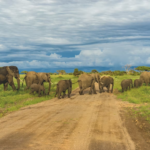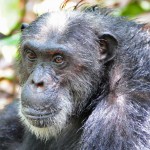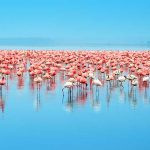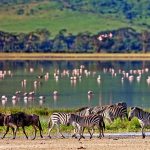The Majestic Birds of Tanzania Worth Knowing

The high safari season is almost here. The landscape transforms from lush green to gradual dry; the dust rises, the sun is shining brighter and the wilderness is brimming in action. During your game drives, the majestic birds of Tanzania have an impressive itinerary planned for you.
Keep your binoculars and cameras handy, but more so, your eyes are ears always vigilant.
Were you always wondering that only several tiny birds commonly fill up the open skies and thick foliage? From stealing prey to performing a courtship dance, watching the largest stork flying and the fastest bird running, here is a sneak peek to the most impressive and large bird species of Tanzania.
The Tallest and Fastest

A pair of Ostrich running freely in the Savannah
It cannot fly, yet with its grace and bold character, there is no way you will want to ignore when in sight. The Ostrich is known to be the largest moving bird in the world, with a speed of 70 km/h distinct in the Savannah; either a black and white male or the classic female in grayish brown feathers. In Tanzania, you are most likely to spot a native Masai ostrich.
Their distinct height helps them to always be aware of predators and pluck seeds, flowers, fruits leaves and insects that are a part of its staple diet. Food alone, does not determine their strength. Thanks to its massive size, an Ostrich can weigh between 60-150 kg and live up to 50 years.
A male Ostrich can have up to 6 hens and each of them can identify its own eggs after the mating season.
The Hunter

The secretary bird scavenging for prey from a great height
The secretary bird gets its original name from Arabic, which means a hunter bird. With its fearless personality, it has the ability to stamp snakes to death in a comical fashion. This is not it. This bizarre looking species can easily catch rodents and other birds and simply swallow it as a whole. One may often spot it on the ground or perched on acacia trees, scavenging for its prey either in a family group or a partner.
Most of the time, this majestic bird of Tanzania can be spotted in open grasslands of the Northern Safari Circuits, in particular the Serengeti.
A Lush of Pink Radiance


Elegant and beautiful, you will often spot the flamingo standing on one leg
Tanzania is a home to the lesser and greater flamingos, a thick population amongst the 5-6 million that thrive in Africa. With a strong preference for water bodies that ensure constant supply of food, travelers can spot a large number of these birds at the Ngorongoro Crater, Lake Natron, Lake Manyara and Arusha National Park.
While the greater flamingos stands tall at a height of 150 cm and are paler with black wings, the lesser flamingos are comparatively smaller (80-90 cm) and prefer to flock together in large numbers. Residing around wetlands, their diet mostly consists of shrimp, plankton and algae. While eating, they are often seen flipping their heads upside down.
Besides its ability to stand on one leg, another interesting fact is that you will barely spot a flamingo alone. These birds are highly social and can be spotted flocking even in thousands.
The Prey Stealer

The fish eagle catches its prey slyly form the surrounding lake
If you are wondering do birds have rivals, the fish eagle is a distinct and remarkable competitor. With its large vertical body, piercing eyes and a yellow bill, you are less likely to miss its sight around lakes and rivers. Besides being active hunters, the African Fish Eagle will even feast on predators such as crocodiles, terrapins and waterfowls. They are often spotted stealing their food from saddle-billed stock and herons.
This soaring bird is often seen soaring in the sky looking for its prey in the water and can catch it within minutes, usually a catfish or a lungfish. You can only imagine how sharp its eyes are. Its sound pitch is so high that it is also called ‘The Voice of Africa”. Its life span is around 40 years.
The Heaviest Flying Bird

One of the most popular ground bird of Tanzania; the kori bustard
Fond of grassy fields and sceneries, they love to stay on the ground and will fly only when necessary. They will barely migrate, only when in need of food and water. When they spread their brown wings one can notice their crest and fly with all its strength, weighing 19 kgs the Kori Bustard is a bird to admire in Ngorongoro and Serengeti.
While the adults mainly feast on snakes, lizards and berries, the chicks prefer mainly insects. Sometimes they have been noticed eating the gum of Acacia trees.
An impressive characteristic of the male bustard is the flattering dance it does for the counterpart during the mating seasons; the ruffling of the feathers, bowing down and making booming sounds makes for a great show for the spectators too. This is often seen during the daytime.
The Social One

The white African pelican taking a flight by the lake .
One of the most captivating birds of Tanzania, the pelican has a long bill with a yellow pouch often seen flocking in a V above shallow lakes. The flight of the Great White Pelican is powerful even in strong winds and they are often seen lingering around water bodies.
Pelicans are known to be social and they will always accompany each other especially while fishing. Lake Rukwa in Tanzania is known as the largest breeding colony of pelicans in Africa. It is not widely known however the diet of these birds is not only restricted to fish. They may also steal chicks of other birds especially seagulls and ducks.
The Largest Stork

The marabou stork waiting for its share of meal form the vulture
Feeble in appearance, the Marabou Stork is the largest wading bird in the stork family and in Tanzania. It is also known as the undertaker bird with its large shape, cloak back and wings, thin legs and a large mass of hair all around its body. These birds are highly noticeable with their thin legs.
Known to be a colonial breeder, you will often spot these birds around arid and wet regions where it also builds its nest and lays eggs. Marabou storks will soar high in the sky and scavenge for, insects, lizards, birds, fish, crocodile eggs and snakes. They often follow vultures and wait to enjoy their share of meat. The Marabou Stork is also known for its ill-temper.
Are you a bird lover? Our safari guides have thoroughly explored the wilderness of Tanzania and will take you to the best bird watching spots. Get in touch and lets us plan the most suitable itinerary for you.

























